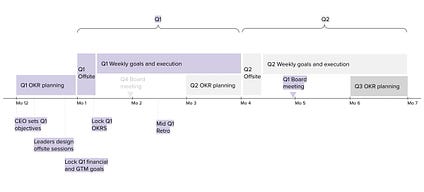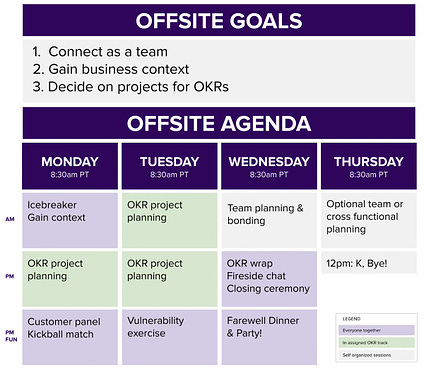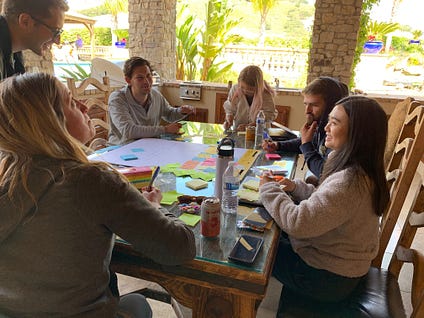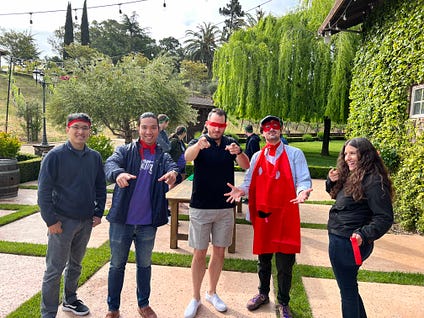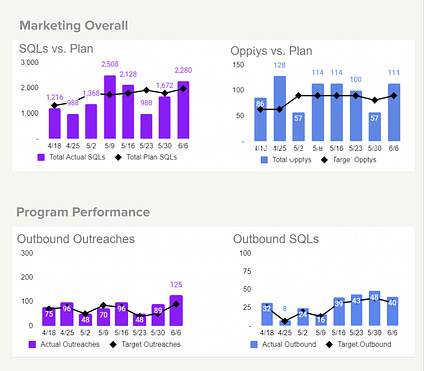The Operating Cadence for Remote Companies
Jaleh Rezaei, CEO and co-founder at Mutiny, published an exceptionally thoughtful blog post the other day about how she and her team designed their operating cadence. The post was so substantive that I asked her if I could re-publish it to my Substack.
As context, Mutiny helps you drive your website conversion rates by scaling the personalization of the website to each user. They’re backed by Sequoia and other VCs (and me!), having recently raised their Series B. I previously published a post with Jaleh about best practices for driving conversion rates.
Thanks for reading! Subscribe for free to receive new posts about scaling B2B SaaS companies and other topics that inspire me.
In this new post, Jaleh explores how her operating cadence provides:
-
Context: How can we inform teammates about the company’s direction, so that they can make the right decisions in their day-to-day work?
-
Engagement: How can we motivate teammates when they’re not all in the same place?
-
Alignment: How can we ensure all team members are aligned on the company strategy and priorities?
We practiced a similar quarterly operating cadence, rooted in OKR methodology, while I was at Gainsight. We called it our “Rhythm,” and we found it transformative.
Hope you enjoy this post as much as I did!
Leadership Roles
Before we dive in to operating cadences, here are a few leadership roles at companies that I’m excited about.
-
Arketa: Head of Demand Gen
-
Explo: Head of Marketing
-
Synctera: Fintech Relationship Manager (critical CSM hire)
By Jaleh Rezaei, CEO and Co-founder at Mutiny
I used to believe that you could only build a successful company in person. The first 6 months of remote were so hard that I thought our company might fail.
Now we’re 100% remote and I can’t imagine ever going back.
The big unlock? A new operating rhythm.
This post shares how we created a new operating rhythm and overcame some of the biggest challenges of building an effective remote company.
The problem with remote work
Mutiny wasn’t always remote-first. The first few years we had a small office in San Francisco where the team would work daily. Then the pandemic hit.
3 months into the pandemic I asked my team what was NOT working. 2 themes were consistent:
-
Our team felt isolated
-
Our team felt that the quality of our decisions went down
We ultimately pinpointed the root cause for both themes to a lack of connection and context.
Lack of connection led to feeling isolated from the team and the mission (both are crucial in an early-stage startup).
Lack of context led to misalignment and bad decisions.
In-person offices have a daily rhythm that remote work lacks
We tried everything and anything to fix it. Zoom happy hours, decision docs, virtual team building. Nothing was as good as in person.
Finally a light bulb went off!
Office culture had a daily rhythm.
Every day, we ran into colleagues in-person and got connection and context. This tiny but consistent wave of energy made us belong and supported better decision making. In the new boxed-in zoom world, this daily rhythm was eliminated.
We needed a new rhythm.
One that generated the same amount of cumulative connection and context, but relied on less frequent in-person time. In other words – one BIG quarterly wave to replace lots of tiny daily waves.
The waves on the left represent the small but important waves that comes from daily interactions with colleagues at an in-person office. To replicate this with a remote team, we needed to create a big quarterly wave to replace lots of tiny waves.
Here’s what we did to improve our remote work set up:
(1) Established a quarterly operating rhythm
(2) Added an in-person offsite as the seminal drumbeat in that rhythm
Here’s a snapshot of what our operating rhythm looks like now:
I’ll break down the most important parts next.
Define quarterly OKRs
OKRs are company-wide initiatives, defined by an inspiring Objective and a Key Result to scope it.
Each quarter I create 4 OKRs with input from my executive team. Any more than 4 company-wide OKRs and you become unfocused. The point of these is to set ambitious (but achievable) goals that move the company forward.
The executive team brings these OKRs to the offsite. During our offsite, our team creates projects to hit the OKRs.
The result is everyone in the company knows exactly what they’re working on for the next 90 days, how success will be measured, and how it ladders up to the company’s highest priorities.
Here’s an example OKR:
Create a consistent structure for offsites
Operating rhythms are valuable because they are repeatable. Our structure repeats quarterly, like a wave.
-
Week 1: Offsite
-
Week 4: Board meeting
-
Week 7: Retrospective
-
Week 9-12: Offsite planning
Offsite goals and agenda are always the same. This makes it easier to organize, but also makes the offsite a core part of our success, not a distraction.
I’ll do a longer writeup about how we structure our offsite exactly, but here’s a snapshot of the quarterly offsite agenda and goals:
Make the operational drumbeat powerful
Our operating rhythm has a drumbeat. That drumbeat is an in-person offsite.
Most offsites focus on presentations or discussions. The reasoning is: “hey, we’re all together in a room! Let’s spend our time together brainstorming on new ideas!”
We disagree with this.
Before arriving to the offsite all team members have context from the pre-reads that were built weeks before. This frees us the most time for in-person debates and FINAL decisions making, including OKRs and projects.
80% business, 100% fun
Pure “kumbaya” offsites aren’t energizing in my opinion.
Smart people want to understand the company’s vision and priorities and engage in making it happen.
That being said, we setup the environment of the offsite to encourage fun. We rent cool spots, eat great food, and give teams time to strengthen their relationships in ways you can’t get over video.
What I’ve found is our team gets so pumped up from being around each other that they organically create the fun (e.g. music videos, collages, dance offs).
Align your board meeting to offsites
Offsites and board meetings require a lot of the same content: priorities, quarterly reflection, closing the books, updating financials.
We schedule our board meeting right after the offsite. This reduces board prep to ~10 hours.
Set weekly goals and execution
My biggest hack for driving execution after the offsite is to translate quarterly goals into weekly goals. e.g. 300 Opportunities/Qtr -> W1=12, W2=24, … W12=300.
Review actual vs. goal dashboards and take action in weekly execution meetings.
Here’s an example of a weekly dashboard showing actual vs. goal:
Course correct at mid quarter retroactive
No matter how hard we try, we always screw something up, usually by oversubscribing ourselves.
Retros help ensure our most important goals come to fruition by giving us a chance to remove lower priority projects or reallocate resources.
Mutiny is remote (and never looking back)
Our quarterly operating rhythm built around offsites has been a game changer.
We get the benefits of remote work (access to talent, live anywhere) without the trade-off of lost connection and context. Next, we’re going to start layering on quarterly public launches and events. Stay tuned for that 😉
In summary:
-
Isolation and poor quality decision making are frequent byproducts of going remote
-
The root cause to both is missing context and connection
-
Establish an operating rhythm that works for your business to overcome this
-
Anchor the rhythm with an effective drumbeat
If you want to learn from more top CEOs about scaling B2B SaaS companies, subscribe for free here!

